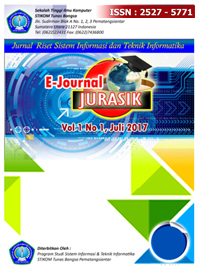Model Optimasi Penentuan Jumlah Dosen dan Ruangan Pada Proses Belajar Mengajar dengan Model Integer Linear Programming
Abstract
Full Text:
PDFReferences
D. E. Surya, “Kompetensi dosen terhadap standarisasi layanan kepada mahasiswa,” Maj. Ilm. UNIKOM, vol. 6, no. 2, pp. 157–168, 2006.
M. Saidi-Mehrabad and P. Fattahi, “Flexible job shop scheduling with tabu search algorithms,” Int. J. Adv. Manuf. Technol., vol. 32, no. 5–6, pp. 563–570, 2007.
D. Abramson, M. K. Amoorthy, and H. Dang, “Simulated annealing cooling schedules for the school timetabling problem,” Asia-Pacific J. Oper. Res., vol. 16, no. 1, p. 1, 1999.
D. W. Nugraha, D. A. Y. Erwin, and S. A. T. S., “Sistem Penjadwalan Perkuliahan M Enggunakan Algoritm a Genetika ( Studi Kasus Pada Jurusan Teknologi Inform Asi Fakultas Teknik Universitas Tadulako ),” Jimt, vol. 14, no. 2, pp. 242–255, 2017.
C. Y. Livia and T. Oktiarso, “Penjadwalan Untuk Memininimalkan Total Tardiness Dengan Metode Integer Linear Programming,” vol. 18, no. 02, pp. 127–137, 2017.
E. Desiana, “Performance Algoritma Genetika (GA) Pada Penjadwalan Mata Pelajaran,” J. Nas. Inform. dan Teknol. Jar., vol. 1, no. 1, pp. 56–60, 2016.
B. J. Maspaitella and J. M. Tupan, “( STUDI KASUS PADA JURUSAN TEKNIK INDUSTRI FAKULTAS TEKNIK UNIVERSITAS PATTIMURA AMBON,” vol. 10, no. 1, 2016.
T. M. Manik, “ANALISIS KARAKTERISTIK FUNGSI LAGRANGE DALAM MENYELESAIKAN PERMASALAHAN OPTIMASI BERKENDALA ABSTRAK,” 2014.
N. Gunantara, Teknik Optimasi, no. October. 2004.
P. A. Everia, “PENJADWALAN KARYAWAN MENGGUNAKAN INTEGER LINEAR PROGRAMMING : STUDI KASUS DI TAMAN AIR TIRTAMAS PALEM INDAH JAKARTA,” Fakultas Matematika dan Ilmu Pengetahuan Alam Institut Pertanian Bogor, 2016.
A. S. P, S. Supian, and R. Sudrajat, “SIMULASI PENJADWALAN PEGAWAI MENGGUNAKAN TEKNIK INTEGER LINEAR PROGRAMMING,” no. 13, pp. 1–10, 2015.
I. M. Wirawan, “Pendekatan Komputasi Numerik Metode Regresi pada Penelitian yang Mengamati Suatu Kecendrungan/Trends Terhadap Peningkatan Hasil/Prestasi Belajar,” Tekno, vol. 25 Maret 2, pp. 17–24, 2016.
T. Riyanto, “Akuntabilitas Finansial dalam Pengelolaan Alokasi Dana Desa (ADD) di Kantor Desa Perangkat Selatan Kecamatan Marangkayu Kabupaten Kutai Kartenegara,” eJournal Adm. Negera, vol. 3, no. 1, pp. 119–130, 2015.
A. Paula and P. S. Kananlua, “Perbedaan Abnormal Return Dan Trading Volume Activity Saham Sebelum Dan Sesudah Reverse Split,” Manag. Insight, vol. 7, pp. 1–11, 2012.
M. R. Munandar, E. S. Astuti, and M. S. Hakam, “Pengaruh Keelamatan, Kesehatan Kerja (K3) dann Insentif terhadap Motivasi dan Kinerja Karyawan (Studi pada Pekerja Bagian Produksi PT. Sekawan Karyatama Mandiri Sidoarjo),” J. Adm. Bisnis, vol. 9, no. 1, pp. 1–9, 2014.
DOI: http://dx.doi.org/10.30645/senaris.v1i0.32
Refbacks
- There are currently no refbacks.
 








